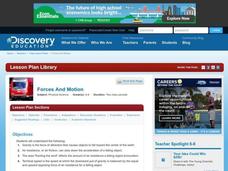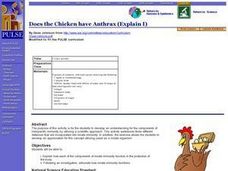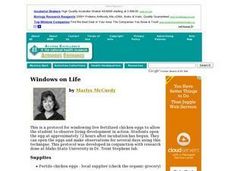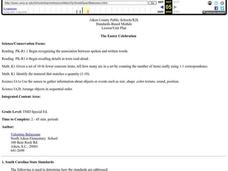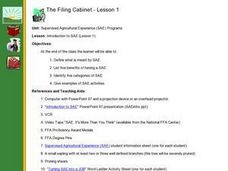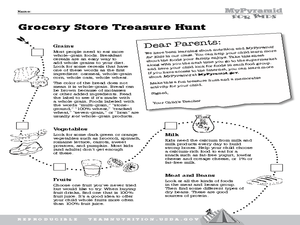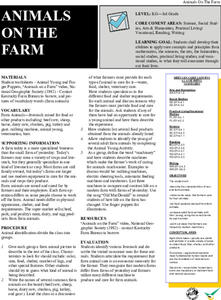Curated OER
Perspectives on Animals
Engage your class in a discussion about humane treatment of animals by recognizing the basic rights of all races, religions, classes, etc. Have volunteers stand on a milk crate without shoes until they become uncomfortable as an example...
Curated OER
Forces and Motion
Students build parachutes for chicken eggs. In this physics lesson, students describe the forces acting on a falling object. They predict which of the three parachute models they made has the best chance of keeping the egg intact after a...
Curated OER
The Shape of Things
Sixth graders read and discuss information regarding the shape and attributes of an eggshell. In this shape of things lesson, 6th graders gather relevant information that pertains to the incubation and formation of an eggshell. ...
Curated OER
Farm Products Help Me Grow
Learners view a display of empty food containers (or illustrations). They select a food and decide as a class if it has an animal or plant origin. Students view a display of common farm animals that are commonly eaten (cow, pig, chicken,...
Curated OER
Where Does Food Come From?
Learners recognize that food we eat comes from farms. In this where does food come from lesson, students discuss planting crops and how they grow. Learners plant seeds for edible crops and eat them when are ripe. Students...
Curated OER
Does the Chicken have Anthrax (Explain I)
Young scholars explain how each of the components of innate immunity function in the protection of the body. Following an investigation, they articulate how innate immunity functions.
Curated OER
Sherlock Shell and the Case of the Missing Chicken
Pupils read and discuss literature in class. They produce a script based upon the model shared during reading and discussion. Students shoot scenes for a final video project.
Curated OER
Embryo Development
High schoolers observe the development of a chicken embryo. In this biology lesson, students compare and contrast the development of human and chick embryo. They make a chart and explain their findings to the class.
Curated OER
Life Cycles
Third graders investigate the stages of animal life cycles. They examine an egg and compare it to an inanimate object, read a booklet about the life cycle and define key vocabulary terms, and observe a mealworm. Students then design a...
Curated OER
A Lucky Break
Young scholars complete activities where they identify and decipher common phrases that are related to poultry and then cook drumsticks as a class. In this poultry lesson plan, students also read the history of the chicken and create...
Curated OER
Life Cycles
Fourth graders explore life cycles. They examine pictures of the various stages of life cycles and put them in the correct order. Students match pictures of eggs to the correct parents. They discuss the importance of knowing the life...
Curated OER
Hatching Chicks
Students create hatching chickens using plastic Easter eggs, yellow cottonballs, small plastic eyes, and orange construction paper in this fun and quick Easter Art lesson for the elementary classroom. A list of recommended craft books...
Curated OER
Windows on Life
Students explore and observe living development using live fertilized chicken eggs. They open the eggs approximately 72 hrs after fertilization and make observations for several days.
Curated OER
The Easter Celebration
Young scholars read a short story about Easter. They recognize and point to pictures of the key words (egg, chicken, rabbit, basket, flower). They make an Easter basket and count how many chickens can fit inside. They also practice...
Curated OER
King Henry's Meat Group
Second graders hear a story about King Henry the Egg, Little D and the meat group. They act out the parts as the story is read aloud and complete a worksheet. They pantomime activities that use and build muscle
Curated OER
Comparative Embryology Using Japanese Medaka Fish
Pupils conduct an experiment to control the breeding of Japanese Medaka fish. They collect the fertilized eggs and view and record the fish's embryological development daily to compare the stages to human development.
Curated OER
Where Does Food Come From?
Distinguish between food and non-food items. Recognize that food is obtained from both plant and animal sources. Identify sources for some common animal foods then construct a simple food path from the farm to the consumer.
Curated OER
The Filing Cabinet - Lesson 1
Young scholars explore and define what is meant by Supervised Agricultural Experience is and list five benefits of having it. They identify five categories of Supervised Agricultural Experience and supply a wealth of examples. Each...
Curated OER
Fossil Find
Young scholars investigate the practice of digging for fossils. They participate in a mock dig of fossils using real bones and other artifacts. Then students dig through sand in order to go through the simulation. Young scholars make...
Curated OER
Possible Outcomes
In this statistics worksheet, young scholars plot the possible statistical outcomes by examining the data and plotting the missing answer for the four problems.
Curated OER
Eat Smart with MyPyramid for Kids
Students investigate food examples from the food groups to explore a healthy diet. In this healthy eating lesson, students study the food pyramid and complete related worksheets. Students also play pyramid go fish.
Curated OER
Marine Habitats of Galveston Island
Four lessons introduce elementary ecologists to salt marsh and sandy beach habitats. In the first lesson, they place shells and other materials in vinegar to determine if they contain calcium carbonate. In the second lesson, they read a...
Curated OER
Animals on the Farm
Students work in groups to create a description of a farm animal. Other classmates try to guess the animal. The class discusses what farmers need to provide for each animal on their farm (food, shelter, veterinary care). Students...
Curated OER
Odd Word Out
In this word association worksheet, students view a large list of words and choose which ones are different as well as why they are different.

